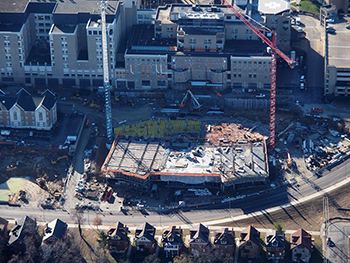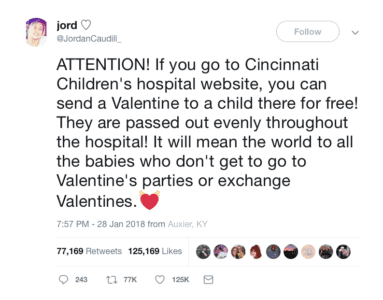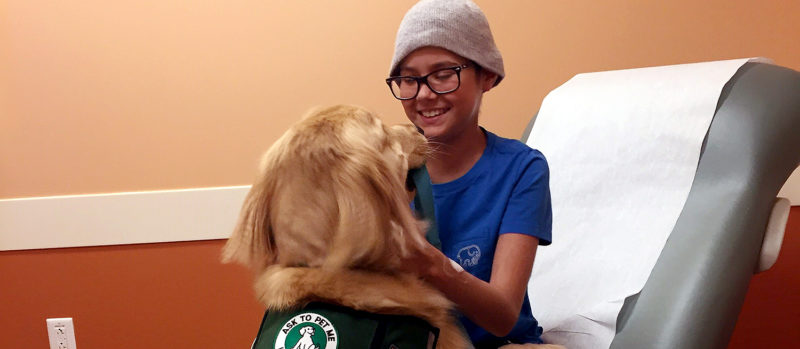2018 was an amazing year at Cincinnati Children’s! From groundbreaking research, to memorable moments and amazing people, it was certainly a year to remember. Here are the top 10 stories from 2018 shown in alphabetical order:
Advances in Organoid Medicine
This year saw many advancements in the field of stem cell and organoid medicine. Scientists at Cincinnati Children’s use a cutting-edge approach that takes a person’s own stem cells to create new tissues, allowing doctors to find answers about a child’s specific disease and how to treat it.
The efforts of this team were highlighted by several advances in organoid medicine in 2018:
- Scientists Grow Human Esophagus in Lab
- Tissue Engineered Human Pancreas Cells Successfully Treat Diabetic Mice
- Search for Genetically Stable Bioengineered Gut and Liver Tissue Advances
- Transformational Gift Boosts Research to Generate Human Organs
Can’t Stop the Healing, Cincinnati Children’s Holiday Video
A video that started as a fun idea to build comradery within the ranks of Cincinnati Children’s Protective Services quickly turned into a viral hit as more than 1 million people viewed the lip sync challenge video on Facebook in the first month it was published. The video shows the spirit of Cincinnati Children’s with patients and staff coming together to sing, dance and celebrate a great 2018.
Chevy and Katie: Best Friends Through Cancer Treatment
Support for children facing life-threating diseases comes in many different forms. For Katie Cobb a golden retriever mix named Chevy was just the support she needed during her treatment for Hodgkin Lymphoma. Read more about Chevy and Katie on the blog.
Critical Care Building Progress
 Great progress has been made on the construction of the Critical Care Building in 2018. The most noticeable feature is construction on the concrete frame of the building. That part of the project will be a key activity for crews over the next several months. Work on the structure and framing is expected to continue through December of 2019. Completion of the project is expected in late 2021.
Great progress has been made on the construction of the Critical Care Building in 2018. The most noticeable feature is construction on the concrete frame of the building. That part of the project will be a key activity for crews over the next several months. Work on the structure and framing is expected to continue through December of 2019. Completion of the project is expected in late 2021.
Melania Trump and Karen Pence Visits
We welcomed First Lady Melania Trump to Cincinnati Children’s in February as she was briefed by our specialists on the care of opioid-affected children. While here, the First Lady learned about Neonatal Abstinence Syndrome (NAS), toured the hospital and met with young patients in one of our activity centers.
Second Lady Karen Pence traveled to Cincinnati Children’s in March where she met with hospital leaders and families who have benefited from music and art therapy.
Courtesy: The White House
New Information About Mono Virus
Cincinnati Children’s researchers made a remarkable discovery involving the virus that causes mono this year.
In a study published in Nature Genetics in April, scientists report the Epstein-Barr virus also increases the risks for some people of developing seven other major diseases. The diseases include systemic lupus erythematosus (SLE), multiple sclerosis (MS), rheumatoid arthritis, juvenile idiopathic arthritis (JIA), inflammatory bowel disease (IBD), celiac disease, and type 1 diabetes.
A New Spot In U.S. News Rankings
For the first time ever, Cincinnati Children’s ranked secondin the nation among all Honor Roll hospitals in U.S.News and World Report’s Best Children’s Hospitals ranking. In addition, our Cancer and Gastroenterology/GI surgery programs both ranked #1 in their specialties.
A New Way to Protect The Brain
Sports Medicine researchers at Cincinnati Children’s have spent several years testing to see if a device called the Q-collar can help prevent traumatic brain injuries in male athletes. After the studies in boys showed promise, this year the work was expanded to include female athletes.
The new study involved the girls’ soccer team at Seton High School, who wore the collar, along with other athletes who did not. All of the girls wore an accelerometer, a computer chip behind the ear, that tracked every hit sustained during practice and games. After the season all of the girls in the study participated in neuro imaging which allows researchers to analyze the data.
Teen with Cerebral Palsy Walks Again
2018 was a big year for Ethan Hogue. After cerebral palsy caused a lack of mobility and forced him to use a wheel chair, the teen is now up and walking. Ethan’s mom talks about his journey in this blog post.
An Epic Valentine’s Day
This year hundreds of thousands of e-valentines flooded Cincinnati Children’s from countries all around the world after a tweet from a woman in eastern Kentucky went viral.
As you can imagine the children were thrilled to feel the love from countries as far away as Argentina, Iraq and New Zealand.




Great work from this social media team!